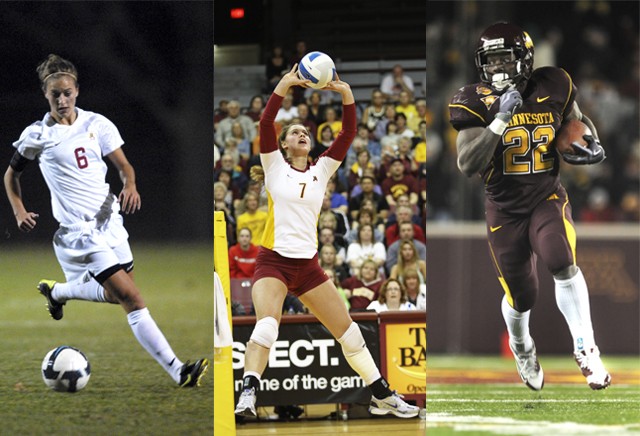Ever since the enactment of Title IX of the Higher Education Amendment Acts of 1972, federal legislation aimed at preventing gender discrimination in educational institutions, the lawâÄôs implications have been a hot-button issue in the world of collegiate athletics. Earlier this month, the U.S. Commission on Civil Rights released a report recommending less stringent compliance standards for Title IX and hinted that the predominant method of compliance leads to a reduction in menâÄôs sports. The commission is an independent, bipartisan agency established by Congress that investigates issues of sex, race, age, disability or national origin. The report stated: âÄúPanelists reported instances of colleges and universities dropping menâÄôs sports programs in order to reach Title IX compliance under the proportional representation.âÄù At the University of Minnesota, some argue Title IX has kept new menâÄôs sports from developing. Alan Merrick, head coach of the University menâÄôs club soccer team, said he would love to bring Division I menâÄôs soccer to the University, which already has a womenâÄôs soccer team. The club team has tried to gain varsity status at the University in the past, Merrick said, but unless another womenâÄôs sport is added, it wonâÄôt happen. âÄúWeâÄôre stuck with Title IX,âÄù Merrick said. âÄúTitle IX precludes that happening to us at this time.âÄù But some experts, like Dr. John Cheslock, a professor and senior research associate at Pennsylvania State University, disagree with the commissionâÄôs findings. Cheslock, who has conducted extensive research on the impact of Title IX, said Title IX itself has not led to a reduction of menâÄôs sports and that such claims are not supported by facts. âÄúIn newspaper op-eds they can sort of fly, but if you get some statisticians in the room they can pretty quickly debunk those and show that, well no, there hasnâÄôt been these large declines in menâÄôs participation,âÄù Cheslock said. Cheslock authored a study in 2008 for the WomenâÄôs Sports Foundation, which found that in response to Title IX, colleges and universities were increasing womenâÄôs participation without decreasing menâÄôs participation. According to the study, between the 1992-93 and 2000-01 academic years, when Title IX was more strictly enforced, womenâÄôs participation increased by 4.5 percent and menâÄôs participation increased by .3 percent annually. Three tests of compliance There are three forms of satisfying Title IX compliance. The first is used by most institutions and calls for universities to have substantial proportional representation in their athletic opportunities âÄî meaning that the number of opportunities should reflect the gender ratio of general student body. The second requires schools to show a history of progress providing athletic opportunities to the underrepresented sex. The third method of compliance, which is perhaps the least rigid, states that universities must show they are adequately accommodating the athletic interests and abilities of the underrepresented sex. The U.S. Commission on Civil RightsâÄô report contends that surveying the student body to gauge athletic interest and ability is an effective way of meeting the third condition. Interpreting the third condition can be difficult, Cheslock said, but the model survey method endorsed by the U.S. Commission on Civil Rights may not be appropriate for large Division I schools who recruit across the country and even internationally. Cheslock said student-athletes interested in a particular sport likely would not attend a school that doesnâÄôt offer that sport. âÄúYour student body is not composed of your potential student-athletes, so surveying them is not really relevant,âÄù Cheslock said. Merrick said there is no doubt that there is enough talent and interest in menâÄôs soccer to field a team capable of competing at the Division I level. Merrick said Minnesota produces a high number of the nationâÄôs top recruits each year. âÄúFor somebody like me, itâÄôs frustrating that weâÄôve got so many wonderful players in the state of Minnesota who are having to go out of state âĦ to find Division I soccer somewhere else,âÄù Merrick said. While Title IX may hinder the chances that Merrick and the menâÄôs club soccer team will one day compete at the NCAA level, it has undeniably led to new opportunities for female athletes, particularly in the sport of rowing. WomenâÄôs rowing coach Wendy Davis said she has experienced the benefits of Title IX first hand. âÄúTo me, what Title IX has done is itâÄôs opened the door for women to experience what men have for a long time,âÄù Davis said. Davis recalled her days at the University of California-Los Angeles from 1978 to 1982, when she said the menâÄôs rowing team received four times more funding than the womenâÄôs team. The rowing team gives women who have no prior experience with the sport a chance to compete at the NCAA level, Davis said. She estimates that 75 percent of the team had not rowed before coming to the University. In order to comply with the proportional representation standard of Title IX, some universities have added womenâÄôs rowing teams to balance the large rosters of Division I football teams. While womenâÄôs rowing is an NCAA sanctioned sport, menâÄôs rowing is not. Davis said that with three coaches and a roster of about 105 last year, rowing is a cost-effective way of increasing womenâÄôs participation. A 2007 study conducted by the National Coalition for Women and Girls in Education found that while women comprise 57 percent of the college population, only 42 percent of athletic participation opportunities are for women. Of the 25 varsity sports offered at the University, 12 are menâÄôs sports and 13 are womenâÄôs.

Image by Ian Larson
Volleyball vs. Texax
Title IX controversy continues
A recent report found that men’s sports were hindered by the Title IX legislation.
Published April 13, 2010
0
More to Discover







